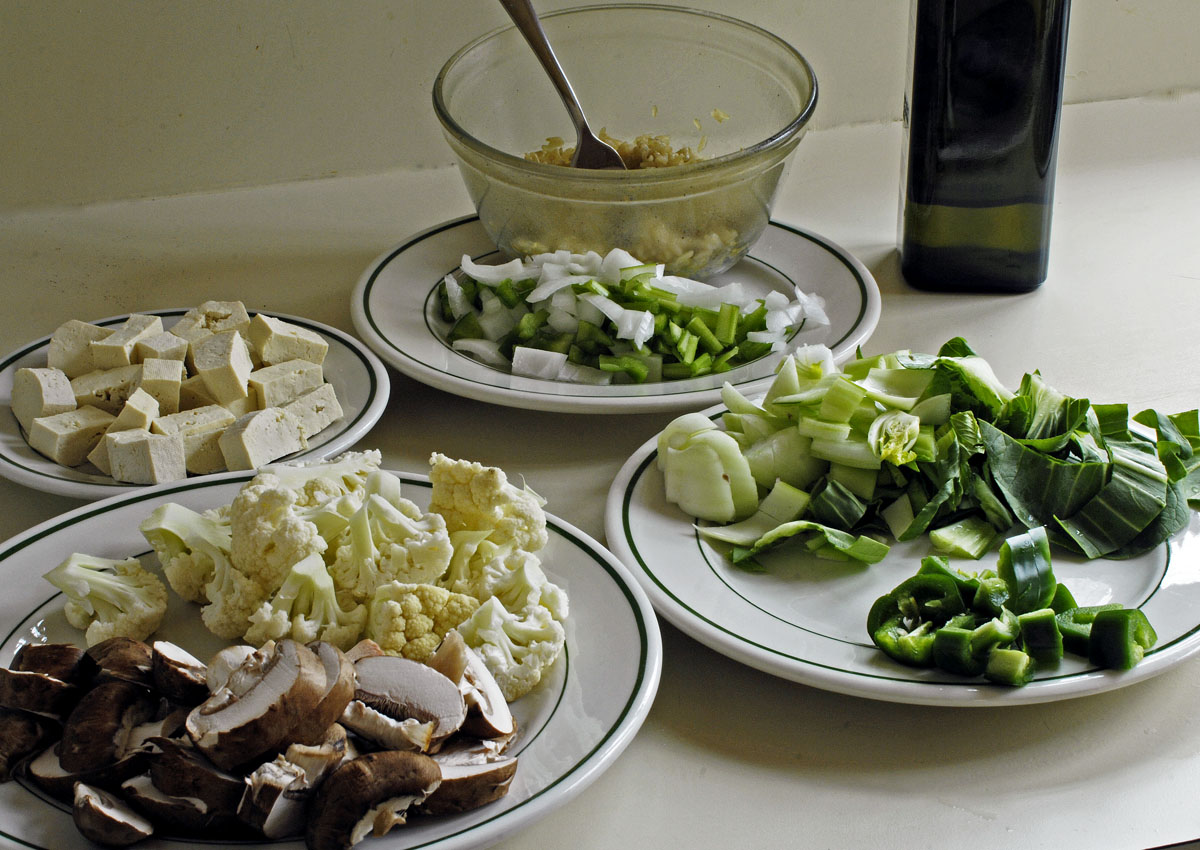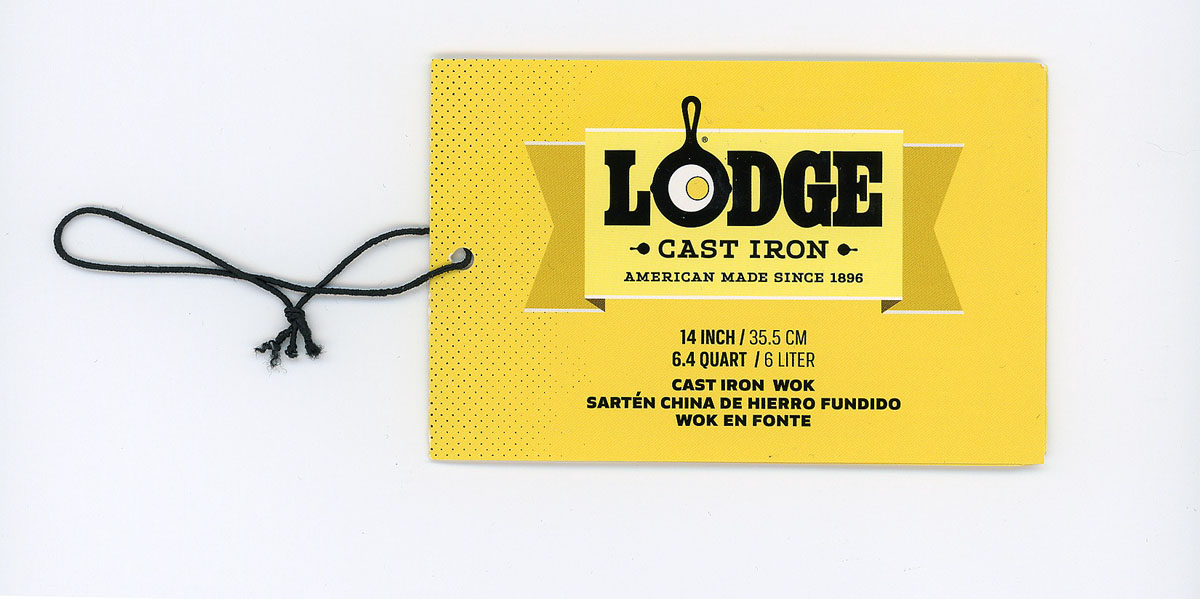
Tofu, fried rice, and mixed vegetables
Stir-frying is such a good way to make low-carb suppers that, for months now, I’ve been having stir-fries for supper three and even four days a week. I had been using a large nonstick skillet, with heat much lower than professional Asian cooks use. I’ve gotten very good at skillet stir-fries, so good that it was time to up my game. That means using a wok, not a skillet.
Not long ago I saw a Lodge cast iron wok in a variety store up in the mountains. The price tag said $99.00. The wok was beautiful, almost magical. I petted it for quite some time but decided not to buy it. The price was just too steep.
Then when I got home, I checked Amazon. Amazon Prime sells the very same Lodge wok for $49.90, shipping included. I ordered it immediately. It’s a shame to cut out local merchants and buy from Amazon. But why should I make a $50 donation to a store that’s willing to overcharge its customers so badly?
The wok comes pre-seasoned, but after I took the wok out of the box I spent a few hours seasoning it a bit more, just to be sure that nothing would stick (and partly to pet it). Nothing did.
Though I have had many good, authentic Chinese meals in San Francisco and New York, and even though I survived a few days in Bangkok with nothing to eat with but chopsticks and soup spoons, I have never watched a professional Asian cook use a wok. YouTube to the rescue. (But be careful — there are also plenty of wok videos made by people who have no idea what they’re doing.)
The amount of heat that professional Asian cooks use is terrifying. Their wok stoves are like blast furnaces. Not to mention that all who are concerned with healthy eating try to keep cooking oils from overheating and smoking, because smoking oils produce carcinogens. If you do some Google searches on this subject, you’ll find several online discussions about just how high heat really needs to be for decent wok cooking at home. The woks of professional Asian cooks may reach 900 degrees F, I understand. Some foodies say that 650F is the minimum. Some claim good results at 450F. But even 650F is too high for my comfort. The smoke point of avocado oil is 500F. That’s my limit, insofar as it’s possible to control the wok’s temperature at every instant of the cooking process.
If you watch YouTube videos of Grace Young cooking in a wok, she is definitely not doing a fire show. She is the author of The Breath of a Wok, which I have ordered. I believe her book is the best-reviewed book written by an Asian for non-Asian cooks using domestic cooking apparatus.
It’s going to take weeks or months for me to get the hang of wok cooking and to figure out where the sweet spot is between a Cantonese fire show and low-smoke home stir-fries. But, even on my first attempt, though I produced a little smoke, the results were like magic. The Chinese call it wok hei, translated “the breath of the wok.” That’s the taste of fire and smoke. Asian fire-show cooks even get short flashes of fire inside their woks while they’re cooking. Don’t try that at home.
I quickly realized that you don’t have to have flash fires in the wok to get (at least some) real wok hei flavor. My first stir-fry did indeed taste like fire. The taste was primal. It was like something that had been cooked outdoors, over a fire, 900 years ago. That’s wok hei.
A friend said (in a text message) that woks are a Platonic sort of cooking vessel. That’s a good way of putting it. The word primal also keeps coming to mind. There is something ancient about the wok, about the cooking process, and about the flavors that you can get. My electric range seems to get hot enough. But if at some point I decide to experiment with murderously high heat, I’ll use a high-powered gas-fired cooking tripod outdoors on the deck.
All the work of wok cooking is in the preparation, because you have to have everything lined up and ready to go. Once you actually start cooking, it’s over in minutes.
The Lodge wok is very big and very heavy. Before you buy one, you might want to figure out where you’re going to store it. I’ll probably store my wok in the oven most of the time. On my electric stove set to high, the 12-pound wok takes about nine minutes to heat up.
Making a wok meal is an hour of patient washing, drying, and slicing followed by a few minutes fire and frenzy.




Your stir-fry supper looks so good. Did you find the platter at Replacements, Ltd?
Hi Jo … Judging from the style of the imprint, that platter is one of my oldest Buffalo China pieces, and I have only one like it. I got it on eBay…
Excuse me for being a little dense here – but why is it that a WOK should be so much better than a skellet ??
Oh sorry, it’s skillet – lolol
I’m using a sauté pan (without the lid), and here’s the difference between a skillet and a sauté pan
https://www.seriouseats.com/2010/05/equipment-whats-the-difference-between-a-skillet-a-fry-pan-and-a-saute-pan.html
Hi Frigast… I think the answer to that would be that, because the wok gets so hot, the deep, rounded shape of the wok makes it easier to keep the food moving in a circular motion so that it doesn’t burn. Whether stirring with a spatula, shaking the wok, or flipping the wok, it’s easier to keep up that circular motion.
Must have Lodge wok. Must have Lodge wok.
In the photo, it looks like a Naguchi sculpture. Makes me want to pet it.
What about putting it on the gas grill on the deck? Just a thought.
Hi DCS: I decided today that the wok has to go to the deck, at least most of the time. I have a lot of learn, but I can’t avoid some smoke, and I don’t want that smoke in the house. The exhaust fan doesn’t help, though I’ve ordered a carbon filter for it.
So today I made a project of sprucing up and reorganizing the deck as an outdoor kitchen for this spring. I have two options for firing the wok on the deck: an 1800-watt induction hot plate; or a heavy duty propane tripod that was sold as part of a turkey fryer. The electric hot plate will be more convenient. I plan to try that out during tomorrow’s fair weather.
So do you not think you could just sit the wok on the gas grill? That is what you got me thinking of since I have a decent gas grill, too. It burns very hot. In fact, with most things, I have to keep it on low. But with the wok, I could run it on high to achieve some “wok hei.”
Don’t you think that would work?
If the weather is nice during spring break, I’m going to try it, and I will report back the results. Maybe I’ll even include pictures — like you.
Hi DCS: My concern would be that, at least with my own gas grill, the flames are too low, and not spaced well, to properly heat the wok. If that works in your situation, that would be fantastic…